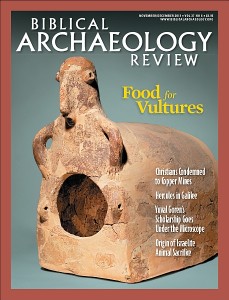
A. Macedonian scepter
B. Assyrian toothpick
C. Roman hairpin
D. Egyptian chariot linchpin
E. Carthaginian drink stirrer
Answer: (C) Roman hairpin
This bone hairpin was undoubtedly the height of fashion tucked in the coiffure of a stylish Roman woman in the third century C.E. Excavated in the 1930s by the Yale-French Excavations at Dura-Europos (in modern Syria), it is now in the collection of the Yale University Art Gallery. Imperial portraits show us how women used single-pronged hairpins to style their hair—available in a variety of materials including gold, silver and ivory—but some experts suggest that they may have been used also to apply cosmetics.
The imagery may not have been for purely aesthetic or decorative purposes, however. The example pictured, measuring nearly 4 inches long, is topped with a figure of Eros, the winged god of love. The woman who wore this hairpin may have been invoking the god’s favor and seeking romantic attention or assistance.
Already a library member? Log in here.
Institution user? Log in with your IP address.

